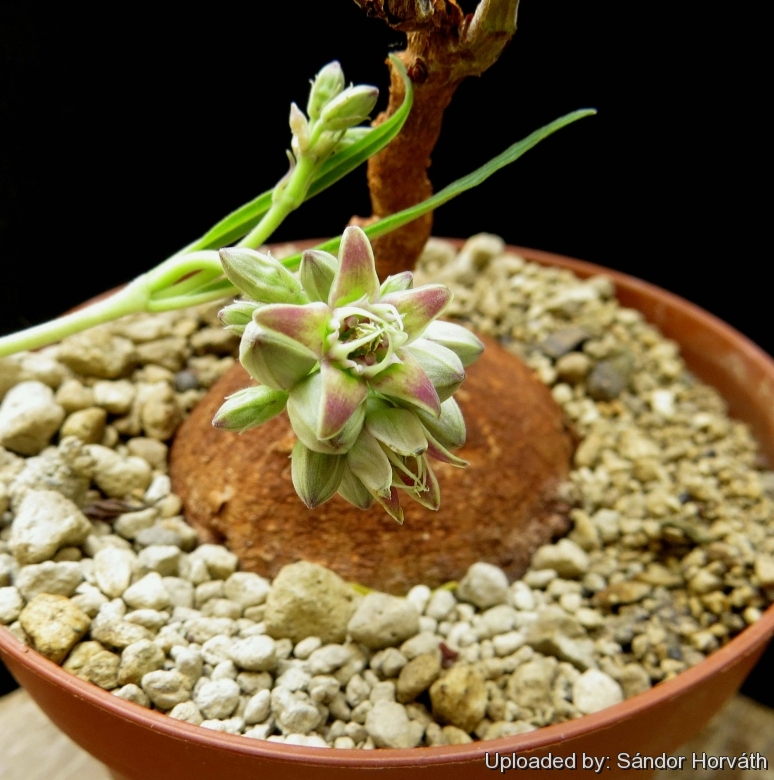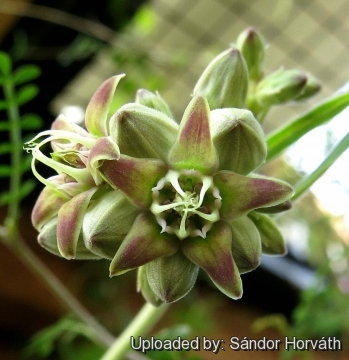Accepted Scientific Name: Raphionacme globosa (K.Schum.) K.Schum.
Bot. Jahrb. Syst. 17: 118 (1893)

Raphiacme globosa (Raphionacme globosa) Photo by: Sándor Horváth
Origin and Habitat: Raphionacme globosaSN|32363]]SN|32363]] is a very widespread species coming from Angola, the Eastern and Northern Provinces of South Africa, Swaziland, Tanzania, Zaire, Zambia, and Zimbabwe.
Habitat and ecology: This species grows in a variety of habitats, often in the fissures of ferruginous rocks in thickets.
Synonyms:
See all synonyms of Raphionacme globosa
back
Accepted name in llifle Database:Raphionacme globosa (K.Schum.) K.Schum.Bot. Jahrb. Syst. 17: 118 (1893)Synonymy: 3
back
Description: Raphionacme globosaSN|32363]]SN|32363]] is a caudiciform asclepiad with herbaceous non twining erect annual stems up to about 50 cm tall, growing from a swollen underground, globose rootstock (caudex), up to 20 cm in diameter. It is a widespread and very variable species with cream, salmon-pink, greenish, or brownish flower in terminal globose heads, hence the specific name. This member of the Asclepiadaceae family was described by K. Schumann in 1893.
Tuber (caudex): Roundish, up to 20 cm diameter, underground in the wild, often raised in cultivation.
Stem: Aerial shoot erect, simple, puberulous, leafy nearly to the apex.
Leaves: Arranged in an alternate or opposite position, distant, 6-14 cm long, 6-12 mm broad, on petioles 2-4 mm long, elongate-lanceolate or linear-lanceolate, minutely pubescent and slightly rough to the touch.
Flowers: In terminal globose heads 18 mm in diameter, on peduncles 6-36 mm long. Bracts 2-5 mm long, subulate or filiform. Pedicels 2-3 mm long, pubescent. Sepals 4-5 mm long, subulate from an ovate base, puberulous, ciliate. Corolla-tube 4-4.5 mm long, campanulate, with 5 small pockets within at the base, lobes 5 mm long, spreading, very minutely puberulous outside, white. Coronal-lobes arising at the mouth of the corolla-tube, divided into three filiform segments, the middle one 4 mmlong, the lateral about 2 mm long.
Fruits (follicles): One or two follicles per flower.
Bibliography: Major references and further lectures
1) N. E. Brown. “Raphiacme globosa” In: “Flora of Tropical Africa” Vol 4, 1904.
2) Focke Albers, Ulrich Meve “Illustrated Handbook of Succulent Plants: Asclepiadaceae: Asclepiadaceae”, Volume 4 Springer Science & Business Media, 2002
3) Françoise Malaisse “How to live and survive in Zambezian open forest (Miombo ecoregion)” Presses Agronomiques de Gembloux, 2010
4) Berthold Seemann “Journal of Botany: British and Foreign,” Volume 50, page 338 West, Newman & Company, 1912
5) Bihrmann's Caudiciforms contributors “Raphionacme globosa” <http://www.bihrmann.com/caudiciforms/subs/bra-nan-sub.asp> Web. 17 January 2016
 Raphiacme globosa (Raphionacme globosa) Photo by: Sándor Horváth
Raphiacme globosa (Raphionacme globosa) Photo by: Sándor HorváthSend a photo of this plant.The gallery now contains thousands of pictures, however it is possible to do even more. We are, of course, seeking photos of species not yet shown in the gallery but not only that, we are also looking for better pictures than those already present.
Read More... Cultivation and Propagation: In cultivation the plants are usually grown in semi shade, with the tubers wholly or (preferably) partially exposed to prevent scorching and rotting of the roots. This plant can take a good deal of water during active growth and should be watered only when not dormant. Keep dryish in winter. It should be overwintered in the greenhouse at temperatures over 12°C (avoid letting temperatures drop lower than 5° C). Use a very draining but rich soil. An error in cultivation may produce unsightly holes in the tuber.
Food uses: This species has a large edible tuber. In West Africa the tuber and fruits are mainly eaten as a famine food. The flesh consists largely of carbohydrate matter.
Reproduction: This species can be reproduced by seeds.











